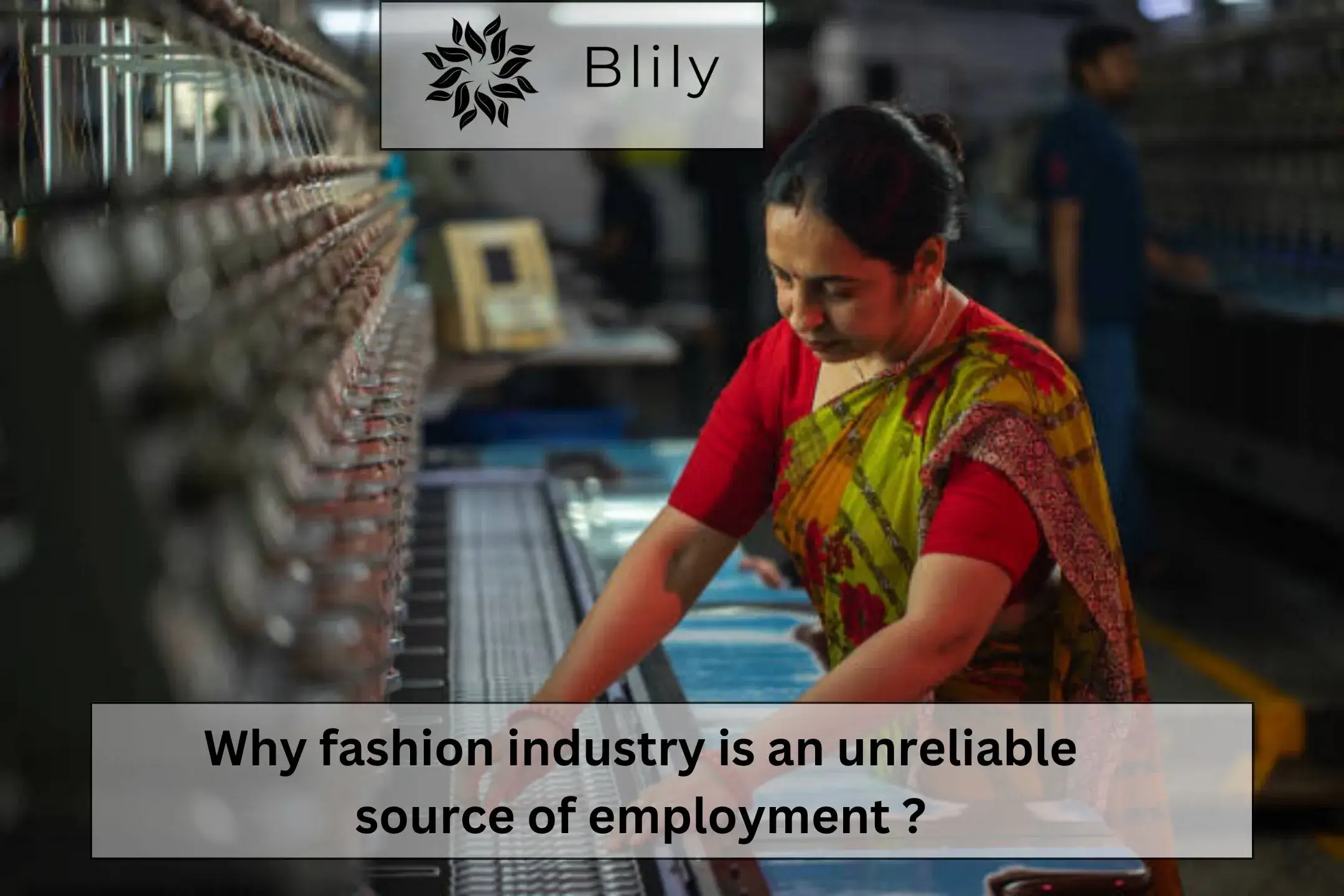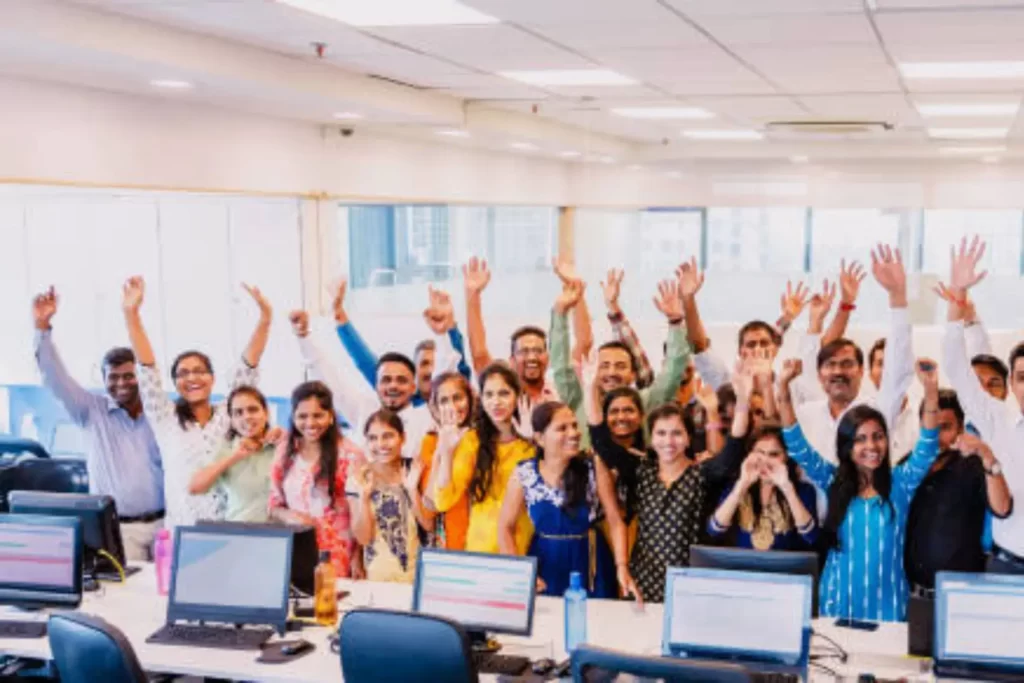Tanace Organics Pvt. Ltd

Why fashion industry is an unreliable source of employment?
The fashion industry is a booming, dynamic sector with a huge impact on the world economy. It includes the creation, production, marketing, and retail of apparel, accessories, and footwear and creates significant financial and job opportunities globally.
Fashion is a medium for self-expression as well as a look into societal norms and cultural trends. The fashion sector has a significant impact on consumers, corporations, and global trade, which is important for influencing economies and modern lives.
The importance of fashion to the world economy may be seen in all of its varied contributions.
First of all, it is a significant contributor to global employment, giving millions of people jobs. The fashion industry offers a variety of job routes, including those for talented designers and craftsmen, shop employees, and marketers.
Secondly, fashion influences consumer spending, promoting economic expansion and making a substantial contribution to the Gross Domestic Product (GDP) of many nations.
Thirdly, the sector encourages creativity and innovation by consistently pushing the limits of design, materials, and technology. The effect of fashion goes beyond economic factors; it also acts as a platform for intercultural communication.
The security of employment, yet, continues to be a major problem in this apparently glamourous sector as it battles issues including seasonal variations, outsourcing, gig work, abusive labour practises, and technological upheavals.
The erratic nature of fashion trends and the need for cost-cutting measures frequently result in irregular and unstable employment opportunities. As the industry navigates through these complexities, addressing the reliability of employment has become a critical issue for the well-being of fashion workers and the sustainable growth of the sector as a whole.
Table of Contents
Historical Perspective of Employment in fashion industry
A significant evolution in labor practices over the ages may be seen in a historical view of employment in the fashion sector. Fashion production used to be a regional and craft industry where skilled craftsmen made each item by hand.

Mechanization and mass manufacturing changed the industry during the Industrial Revolution, bringing in the creation of factories and the standardization of apparel. Job specialization and the creation of an industrial workforce were two results of this transition.
Outsourcing and offshore practises grew in popularity as the fashion industry got increasingly globalised, changing employment trends and job security in traditional manufacturing countries.
The past has seen cyclical changes in job security and stability, with seasonal demand and recessions having an impact on employment possibilities in the fashion industry. Technology and globalisation developments have improved productivity and efficiency, but they have also caused uncertainty for fashion workers as the sector struggles to strike a balance between innovation and job security.
Outsourcing and Offshoring
The fashion sector has seen a major rise in offshoring and outsourcing, which has altered the domestic job market and the worldwide supply chain. Many fashion brands and businesses have turned to outsourcing in their drive for cost-effectiveness and expanded production capacity, handing certain jobs to outside vendors and suppliers for things like manufacturing, fabrics, and shipping.
Fashion businesses may now concentrate on design, marketing, and brand management by utilising resources and specialised expertise from other countries.
However, the expansion of offshoring—the shifting of production to less expensive nations—has had a significant impact on domestic employment in long-established centres of the fashion manufacturing industry. Local workers frequently experience job displacement, decreased job security, and pay pressures as jobs migrate elsewhere.
Offshoring and outsourcing have advantages in terms of cost savings and access to international markets, but they also pose issues with worker rights, job security, and the viability of fashion businesses in home nations. In the age of globalisation, the fashion sector still faces significant challenges in retaining domestic employment possibilities while being competitive on the global market.
Exploitative Labor Practices
Sweatshops and unfair pay are two major examples of the exploitative labour practises that have long plagued the fashion industry. Many garment workers now live in the sad realities of sweatshops, which are characterised by subpar working conditions, lengthy workdays, and low pay, particularly in developing nations with inadequate labour laws. The well-being of the labour suffers greatly as a result of these sweatshops’ frequent emphasis on maximising productivity at the price of it.
Fast fashion, with its emphasis on quick and inexpensive production, exacerbates the problem by driving an insatiable demand for cheap labor and rapid output. Workers in this system often face hazardous environments, inadequate safety measures, and meager wages, perpetuating a cycle of exploitation. The impact of exploitative labor practices is profound, with workers facing a lack of job security, limited opportunities for growth, and an increased risk of physical and mental health issues. Addressing these dark aspects of fast fashion and labor practices is crucial for fostering a more ethical and humane fashion industry that respects the dignity and rights of all workers.
Technological Disruptions in fashion industry

The fashion industry is experiencing significant technological disruptions, particularly with the increasing integration of automation and robotics in fashion manufacturing. Advancements in technology have revolutionized the production process, enabling faster, more precise, and cost-effective methods of creating garments and accessories. Automated systems and robots can handle tasks traditionally performed by human workers, such as cutting, sewing, and pattern making. While these technological advancements offer benefits in terms of efficiency and productivity, they also have a substantial impact on job opportunities within the industry.
As automation and robotics replace certain manual labor tasks, the demand for traditional manufacturing jobs may decrease, leading to potential job displacement for workers in garment factories and textile mills. On the other hand, technology also creates new job opportunities, such as roles related to programming and maintenance of automated systems. The challenge lies in striking a balance between embracing technological progress for its efficiency gains and addressing the potential social and economic consequences on the workforce. A thoughtful approach to reskilling and upskilling workers for emerging roles will be crucial to ensure a sustainable and inclusive future for the fashion industry amidst these technological disruptions.
Unpredictable Business Cycles
The fashion industry is highly susceptible to unpredictable business cycles, with economic downturns significantly impacting fashion employment. During recessionary periods, consumer spending on non-essential items like clothing and luxury goods tends to decrease, leading to reduced demand for fashion products. As a result, fashion companies may face declining sales and profitability, prompting cost-cutting measures, including workforce reductions and layoffs. Workers in the fashion sector, particularly those employed in retail, manufacturing, and design, are vulnerable during these times, facing the risk of job loss, reduced working hours, and stagnant wages.
Additionally, fashion brands may resort to outsourcing and offshoring practices to cut expenses, further affecting domestic employment opportunities. The impact of economic downturns on fashion employment can create long-lasting effects on workers’ livelihoods, well-being, and job stability. Policymakers and industry leaders must focus on fostering resilience, diversification, and support systems for fashion workers during such economic downturns to mitigate the negative consequences and promote a more sustainable and secure workforce in the face of unpredictable business cycles.
Ageism and Discrimination
Age discrimination is a pervasive issue within the fashion sector, often leading to challenges for older workers. In an industry that heavily emphasizes youth and beauty, older individuals may encounter difficulties in finding employment or advancing their careers. Fashion brands and companies, influenced by societal beauty standards and the pursuit of youthful appeal, tend to prioritize younger talent, sidelining older professionals who may bring valuable experience and skills to the table.
As a result, older workers face barriers in securing job opportunities and promotions, despite their qualifications and expertise. The prevalence of ageism in the fashion industry can create a sense of exclusion and diminished job prospects for seasoned professionals, leading to a loss of diversity and inclusivity within the workforce. Addressing age discrimination and recognizing the value of experience and knowledge that older workers bring to the fashion industry are essential steps toward fostering a more inclusive, age-diverse, and vibrant workforce within the sector.
Influence of Social Media
Social media has exerted a profound impact on job expectations and self-employment within the fashion industry, largely driven by the rise of influencer culture. The widespread use of platforms like Instagram, YouTube, and TikTok has transformed how fashion professionals market themselves and connect with audiences. Influencers, with their large followings and ability to shape trends, have become powerful figures in the industry, redefining what success and career opportunities look like.
As a result, job expectations in fashion have shifted, with many aspiring to pursue careers as influencers, content creators, and brand ambassadors. This rise of influencer culture has also disrupted traditional jobs in the industry, as marketing and advertising strategies increasingly rely on influencer partnerships and digital content creation.
While social media has opened doors for self-employment and entrepreneurship, it has also intensified competition and raised questions about the authenticity of online personas. As the influence of social media continues to shape the landscape of the fashion industry, individuals and businesses must adapt to the evolving job market, finding innovative ways to leverage digital platforms while preserving the integrity and diversity of traditional roles within the sector.
Sustainability and Employment
The fashion industry has witnessed a growing emphasis on sustainability, leading to a transformation in how businesses operate and how job creation is impacted. As environmental and social concerns have gained prominence, fashion brands and companies are increasingly adopting sustainable practices throughout their supply chains. From sourcing eco-friendly materials and implementing circular fashion models to reducing waste and carbon emissions, these sustainability initiatives create new job opportunities and drive changes in existing roles.
Job creation occurs across various aspects, including research and development of sustainable materials, product design and manufacturing, supply chain management, and marketing and communication of sustainable initiatives.
Moreover, the adoption of sustainable practices necessitates a shift in workforce skills, leading to increased demand for professionals with expertise in sustainable fashion, ethical practices, and environmental stewardship. As sustainability becomes a core value in the fashion industry, the intersection of job creation and environmental responsibility presents an opportunity for a more responsible and prosperous future for both workers and the planet.
The Role of Education and Training
Education and skill development play a crucial role in shaping employability within the fashion industry. The importance of continuous learning cannot be overstated, as the sector constantly evolves with changing consumer preferences, technological advancements, and sustainability imperatives.
Education equips aspiring fashion professionals with essential knowledge, technical expertise, and creative skills necessary for success in various roles, including design, merchandising, marketing, and management. Formal education in fashion schools and universities provides a solid foundation, but the industry’s fast-paced nature demands ongoing training and upskilling to remain relevant and competitive.
Continuous learning not only enhances employability by adapting to the latest trends and innovations but also fosters adaptability and resilience in navigating the dynamic challenges of the fashion industry. As the sector embraces sustainability and ethical practices, education also plays a crucial role in promoting responsible fashion and preparing the workforce for the demands of a more environmentally and socially conscious industry.
A commitment to lifelong learning ensures that fashion professionals can thrive amidst industry changes, contribute to positive transformation, and secure their positions in a highly competitive and ever-evolving fashion landscape.
Job Insecurity and Mental Health

Job insecurity in the unpredictable fashion industry can take a significant toll on the mental health of fashion workers. The constant uncertainty regarding employment prospects, the pressure to maintain creativity and productivity, and the fear of job loss contribute to heightened stress, anxiety, and burnout.
Workers may experience feelings of inadequacy and self-doubt as they strive to meet demanding expectations in a highly competitive environment. Coping mechanisms and support systems are essential for addressing these challenges.
Fashion professionals often rely on resilience-building strategies, such as mindfulness practices, seeking mentorship, and engaging in peer support networks, to navigate the emotional strains of job insecurity. Employers and industry leaders also play a crucial role in fostering a supportive and inclusive work culture that prioritizes mental health.
By providing resources like employee assistance programs, mental health awareness training, and open communication channels, the fashion industry can create a more compassionate and understanding environment, promoting the well-being of its workforce and ultimately improving job satisfaction and productivity in the face of the uncertainties that characterize the industry.
Financial Planning and Instability
In the face of an unreliable fashion industry, managing finances becomes paramount for fashion professionals. The unpredictable nature of the sector, with its seasonal fluctuations and economic uncertainties, requires individuals to adopt prudent financial planning practices. Saving for rainy days, creating emergency funds, and setting realistic budgets can provide a safety net during periods of job instability.
Developing multiple streams of income, such as freelance work or side projects, can also help cushion the impact of potential job losses. Moreover, financial preparedness involves understanding the cyclical nature of the fashion industry and anticipating potential challenges to maintain stability.
By adopting responsible financial habits and seeking professional financial advice, fashion workers can safeguard their financial well-being and build resilience in the face of the industry’s uncertainties, enabling them to weather economic downturns and pursue long-term career goals with greater confidence.
Government Regulations and Policies
The fashion industry operates within a framework of labor laws and regulations that govern various aspects of employment. These laws encompass working hours, minimum wage, health and safety standards, and worker rights.
However, there are often gaps and challenges in enforcing these regulations, particularly in countries where the fashion industry outsources production to lower-cost regions with weaker labor protections. To improve job stability in the fashion sector, potential policy changes could focus on strengthening labor enforcement mechanisms, ensuring fair and safe working conditions, and combating exploitative labor practices, such as forced labor and child labor.
Additionally, governments could incentivize sustainable practices through tax breaks or subsidies, encouraging fashion brands to prioritize responsible production and job creation in their home countries.
Policymakers could also invest in workforce development programs to equip fashion workers with the skills needed for the industry’s evolving landscape, fostering greater job security and employability. By proactively addressing labor-related challenges and promoting responsible business practices, governments can play a critical role in enhancing job stability and creating a more sustainable and ethical fashion industry.
Globalization and Employment
Globalization has profoundly impacted fashion jobs, reshaping the industry’s employment landscape and creating job opportunities in various regions of the world. International trade has facilitated the movement of fashion goods and services across borders, allowing companies to access diverse markets and expand their global reach. As a result, fashion brands have established production hubs in countries with competitive advantages in terms of labor costs and expertise.
Developing nations, particularly in Southeast Asia and South Asia, have become significant players in fashion manufacturing, providing a vast pool of skilled and low-cost labor. Simultaneously, regions such as Europe and North America continue to thrive as centers of fashion design, marketing, and retail, offering job opportunities in creative and managerial roles.
The globalization of the fashion industry has spurred cross-cultural collaborations, leading to the fusion of diverse design influences and new avenues for fashion careers. However, it has also raised concerns about labor standards, workers’ rights, and environmental impacts in developing countries. Balancing the benefits of globalization with ethical considerations remains a critical challenge for the industry, as stakeholders seek to create a sustainable and inclusive global fashion workforce.
Addressing the Reliability Issue
Enhancing job stability in the fashion industry requires a multi-faceted approach and collaborative efforts through industry-wide initiatives. First, fashion companies can invest in workforce development and training programs, empowering employees with adaptable skills and fostering a resilient workforce better equipped to navigate industry changes.
Additionally, adopting ethical and sustainable business practices can promote job stability by ensuring responsible supply chains and supporting fair labor standards. Governments can play a vital role by enforcing and strengthening labor regulations, safeguarding workers’ rights, and incentivizing companies to prioritize domestic job creation.
Collaborative efforts between fashion brands, trade unions, and NGOs can drive collective action towards addressing industry challenges, such as ageism, job insecurity, and exploitative labor practices. Creating transparent communication channels and feedback mechanisms between employers and employees can foster a supportive work culture and address issues promptly.
Furthermore, industry-wide initiatives promoting diversity, inclusivity, and mental health awareness can contribute to a more equitable and sustainable fashion workforce. By uniting stakeholders and aligning their efforts, the fashion industry can proactively tackle the reliability issue, cultivating an environment that values and protects its workers while embracing positive changes for the future.
Conclusion
In conclusion, fashion workers confront a myriad of challenges and uncertainties in their pursuit of a career within the industry. From the prevalence of gig-based employment and age discrimination to the influence of social media and technological disruptions, job stability remains elusive. The unpredictable nature of business cycles, coupled with the impact of globalization and exploitative labor practices, further compounds the vulnerabilities faced by fashion professionals.
However, amidst these challenges, one resounding call emerges: the urgent need for sustainable change in the fashion industry. Emphasizing ethical practices, responsible production, and fair labor standards can pave the way for a more stable and inclusive fashion workforce.
Collaboration among stakeholders, from governments and businesses to trade unions and consumers, is crucial to drive collective efforts in creating a fashion industry that values its workers, fosters innovation, and ensures a more sustainable future. Only through joint commitment and concerted actions can the industry rise to the challenge and create a transformative path towards a more reliable, equitable, and resilient fashion landscape.







